About a week after I wrapped up my last article where I talked about needing another stage of amplification to take advantage of my new 0.4mV phono cartridge, all the remaining bits and pieces I had ordered online to build the Muffsy phono head amplifier kit arrived. I had the amplifier kit, the power supply kit, the back-panel kit (all from Muffsy), the case (from a very efficient supplier in China), the temperature-controlled soldering station, and the wall wart (from a very efficient supplier in California).
I watched the entertaining "how to solder" videos linked on Muffsy's site and realized I needed a few more things—like the thin solder mentioned on those videos and some solder wick. So, on an unusually bright and sunny Saturday morning, I visited a local electronics supply store, picked up the last items, and started building.
To my great surprise, the build went very well. I had intended to take a few intermediate pictures and include them in this article, but I got so carried away with my new soldering station and my new soldering skills that I was done before I knew it! Therefore, I've used some images from the instructions pages on Muffsy's site.
Also, I should point out that all the information on the Muffsy website is licensed under Creative Commons, with the sole exception of the printed circuit board designs, which may not be used commercially without prior approval from the designer. More information is available here.
Step 0: Getting ready
Several preliminary activities are worth mentioning. The workspace should be clean, well-lit, and properly ventilated. Since I had the house to myself, I repurposed the kitchen island, which is a great height for me and has a nice, old maple butcher-block top. This let me use a room fan and the cooktop's ventilation to evacuate the rosin fumes from the soldering. I had lots of room to work, even with the laptop set up nearby (to follow the instructions). I also verified the parts received—including using my multimeter to check resistor values—against the parts lists on the instructions site. I also test-fitted the boards and casework. Finally, I was all set.
Step 1: The power supply
Neither the Muffsy phono preamplifier nor the head amp circuit boards incorporate a direct current (DC) power supply, so the would-be builder must either purchase the Muffsy power supply kit or come up with something somewhere else. I opted for Muffsy's kit and decided to build it first.
The power supply kit instructions suggest carrying out the soldering in several steps:
- Diodes, which rectify the incoming alternating current (AC)
- Resistors
- Small capacitors
- Voltage regulator integrated circuits (ICs)
- Large capacitors
The final step—soldering the screw terminals for the incoming AC and outgoing DC—is left until after the amplifier board is completed.
The build documentation is quite wonderful with a view of the circuit board showing the locations of the groups of components for each step, along with alignment instructions for the ICs and the large capacitors, and photos showing the correct orientation.
As an example, the image below shows the location of the voltage regulator components (the pads marked in yellow). The idea is that the builder uses the label adjacent to the yellow pad (LM317, LM337, LM78XX) to identify which IC goes where and uses the silver bar to the right of the 317 and 337 and above the 78XX to identify the orientation of the heat-sink tab.

opensource.com
The image below shows the voltage regulators correctly mounted on the board, with the arrows showing the correct IC and the orientation of the heat-sink tabs visible.
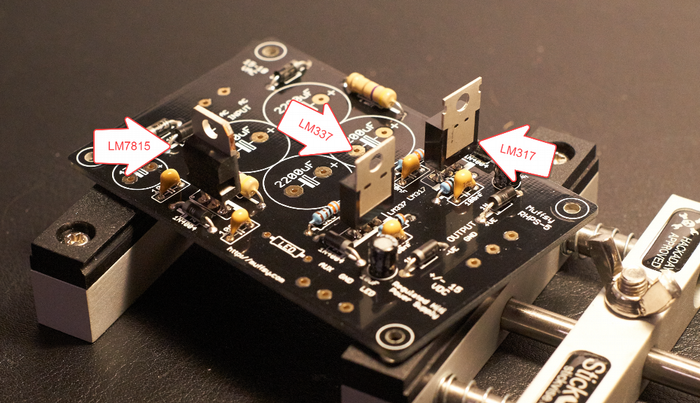
opensource.com
These kinds of instructions and supporting images make the assembly process straightforward and low-stress. A lot of care went into the preparation of the instructions, and I don't recall ever feeling uncertain during the build.
Once the power supply is done, it's time to turn to the amplifier board.
Step 2: The amplifier
Just a quick review of my situation before I start on the build. I already have a phono preamplifier in my home stereo, but it only supplies enough gain for a typical moving magnet phono cartridge. That is, it is designed for a cartridge that generates a nominal voltage of 3–6 mV (millivolts; that is, 0.003–0.006 volts). These days, I have a moving coil cartridge that generates about 1/10th of that amount—0.4 mV, or 0.0004 volts. I needed a step-up device, and the Muffsy head amp fits my needs very well.
The head amplifier board is the same size as the power supply board but requires a different set of components.
The instructions are very similar in nature and quality to the power supply's directions. The build order in this case is:
- Resistors
- Sockets for the amplifier and servo ICs
- The switch used to adjust input impedance
- Capacitors
- The screw terminal that accepts the DC from the power supply
- Finally, the large capacitors
Then it's time to wire up the amplifier board to the screw terminal for the power supply board, solder the AC connections between the amplifier board and power supply board, put together the back panel, and solder all the connections to it.
This was the only point I ran into difficulties during the whole build. I found the shielded audio cables—provided to connect the jacks on the back panel to the amplifier—extremely difficult to strip. There is probably a stripping tool specifically designed for this type of application, but I found it very hard to apply the right force to cut through the outside insulation without severing the fine shield conductors.
The image below shows the fully wired amplifier board.
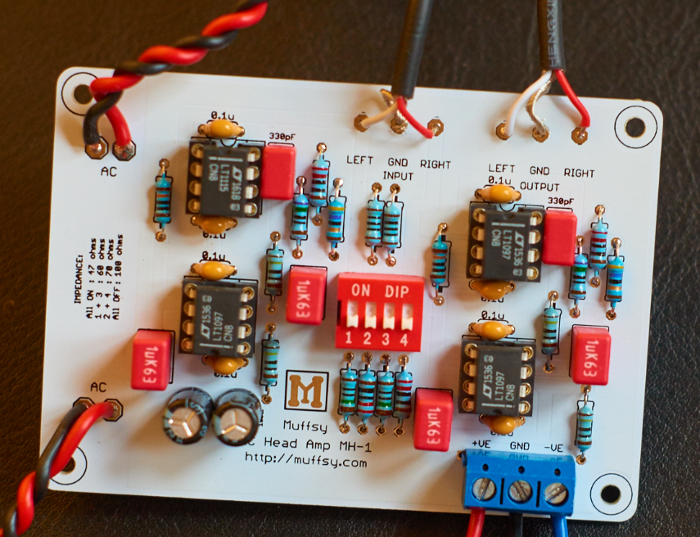
opensource.com
At this point I should mention that I chose to build the head amp with the standard amount of gain (about 17, that is, my cartridge's nominal signal of 0.4 mV will generate an output of 6.7 mV), but I chose the alternate set of input impedances (69, 100, 127, 300 ohms), which seemed to better suit my cartridge. All of these changes are realized by replacing a few of the standard resistors. Alternative gain resistors are not included in the kit, but all the resistors necessary for changing the input impedance are provided.
The image below shows my final built project (with the lid removed).
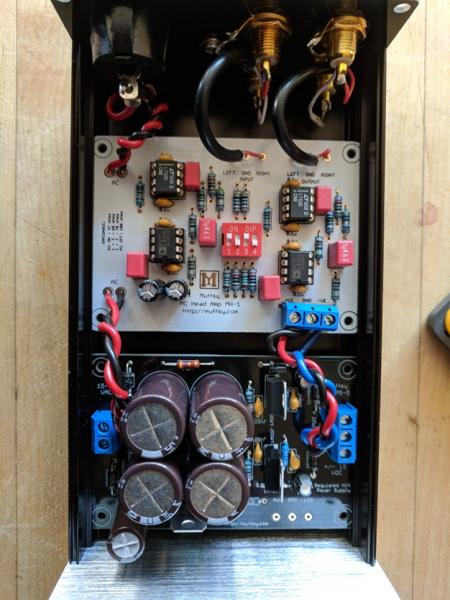
opensource.com
That's it! I would say this took about six hours from start to finish, but that's just a rough guess. I have built a few things before and have reasonable experience with reading resistor codes, soldering, and the like, but I'm no kind of electrical whiz.
What about the results? Well, given my years of experience writing code, I have to say I was completely stunned when IT WORKED THE FIRST TIME. Really! The finished project sounds great and, as I hoped, is a good match for my cartridge and the rest of my stereo. In fact, I think I might put a record on right now...
Closing comments
I contacted "the person behind Muffsy," Håvard Skrodahl, with some questions. He responded very quickly, and we ended up having a most delightful conversation. Moreover, it turns out Håvard is a system administrator and does this "kit thing" as a side gig. We discussed (or maybe lamented) that "back in the good old days" it was possible to buy all sorts of electronics kits, from Heathkit, Dynaco, David Hafler, and others. Today, there are still audio kits available, but it seems to be of lesser interest. Too bad! I am very grateful to Håvard for open sourcing so much of his materials.
Now that I've got the great new soldering station, I need to find some more things like this to do.
And the music...
I can't leave without a few quick music recommendations. First, ripped from a CD purchased online is Lenine's O Dia Em Que Faremos Contato. What a great album! I have a few compilation albums where some of Lenine's work shows up, and over the years I've managed to buy two other CD releases. (I would LOVE to find some of this stuff on vinyl.) Check out this nice live performance of the song of the same name.
I've recently bought two great downloads from 7digital, one of my favorite Linux-friendly sites. The first is Jon Hopkins' Immunity, a fine album of electronica; the second, Nabihah Iqbal's Weighing of the Heart, also electronica-ish, which is also available on Bandcamp and which I picked up just in time to celebrate International Women's Day 2018.
All good music! But I really must get to the record store for that big celebration and pick up some more vinyl!

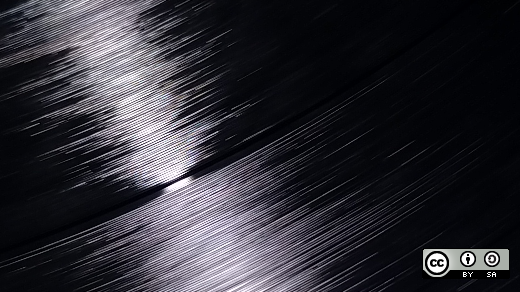



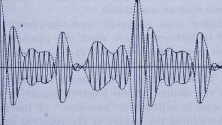

Comments are closed.